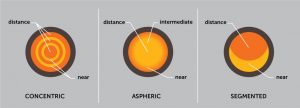Are you a contact lens wearer? If so, you’ve probably heard some myths about wearing contact lenses. Typically, these contact lens myths grow from an unusual experience or misunderstanding information. Many contact lens myths are based on the way contact lenses used to be, instead of the current design and technology of contact lenses. We wanted to debunk some of the contact lens myths and give you the facts instead!
1.I’m too old to wear contact lenses
Fact: Anyone, at any age can wear contact lenses. Many older adults choose to wear contact lenses instead of reading glasses.
2. Contact lenses will get lost behind my eye
Fact: It is physically impossible for a contact lens to get lost behind your eye. A membrane covers your eye which connects inside your eyelids to prevent anything from getting behind your eye.
3. Contact lenses are uncomfortable
Fact: Modern contact lenses are thin and soft, making them very comfortable and often unnoticeable to wear. Some of the early contact lenses made 40-50 years ago were uncomfortable. However, we recommend you try modern contact lenses before sticking with this assumption.
4. Contact lenses can get stuck on my eye
Fact: If you follow proper wear, care, and removal advice from your eye doctor your contact lens cannot get stuck to your eye. Should your lens feel dry, apply some rewetting drops, and they should loosen right up.
5. Contact lenses are too much trouble to take care of
Fact: Daily disposable contact lenses make lens care irrelevant. You wear them one day and throw them out when you are done. However, reusable contact lens care is relatively simple with modern solutions. Most contact lenses can be cleaned and stored using one multi-use contact lens solution.
6. I’ll never be able to put in contact lenses
Fact: Our staff will show and teach you how to put in contact lenses. We ensure that you are confident in your abilities to put in and take out your contacts before you leave our office. Most people can figure it out after a handful of tries!
7. Contacts can pop out of my eye
Fact: Properly fitted contact lenses should never pop out of your eye. Typically, the only way a contact lens will move is shifting around your eye. Therefore blinking a few times or closing your eyelid and gently pressing on it should move the lens right back into place.
8. Contact lenses are too expensive
Fact: The cost of contact lenses varies depending on brand, replacement schedule, and how often you wear them. Typically, the price is comparable to a new pair of glasses. Above all our team will help you select contact lenses that work best for your lifestyle and your budget.
9. Children and teenagers cannot wear contacts
Fact: There is no age restriction on wearing contacts. Anyone can wear contact lenses; ultimately it depends on enthusiasm, responsibility, and maturity. Our staff can advise whether contact lenses are a suitable option for your child.
If you have more questions about contact lenses, give our office a call! We want to help you feel confident in your knowledge of contact lenses.


 Although it’s unlikely that demand for traditional glasses will ever disappear altogether (after all, they’re stylish, comfortable, and convenient), contact lenses have been popular for decades and continue to be a great choice for eyewear. From typical prescription options, to ones that change the color of the eye, to futuristic “smart” lenses—contacts have come a long way since 1888!
Although it’s unlikely that demand for traditional glasses will ever disappear altogether (after all, they’re stylish, comfortable, and convenient), contact lenses have been popular for decades and continue to be a great choice for eyewear. From typical prescription options, to ones that change the color of the eye, to futuristic “smart” lenses—contacts have come a long way since 1888!